Chicago Park District
The Chicago Park District is one of the oldest and the largest park districts in the United States. As of 2016, there are over 600 parks included in the Chicago Park District as well as 27 beaches, several boat harbors, two botanic conservatories, a zoo, and 11 museums. The Chicago Park District also has more than over 230 field houses, 78 public pools, and dozens of sports and recreational facilities, with year-round programming. The district is an independent taxing authority as defined by Illinois State Statute and is considered a separate (or "sister") agency of the City of Chicago. The district's general superintendent and CEO, Michael P. Kelly, was appointed by the mayor of Chicago and confirmed by the board of commissioners in 2011.[1] The district's headquarters are located in the Time-Life Building in the Streeterville neighborhood.
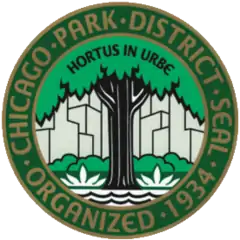 | |
| Agency overview | |
|---|---|
| Formed | Consolidated in 1934 Predecessors founded in 1869 |
| Jurisdiction | Government of Chicago |
| Headquarters | 541 N. Fairbanks Court Chicago, Illinois 60611 |
| Annual budget | $385 million |
| Agency executive |
|
| Child agency | |
| Website | chicagoparkdistrict |
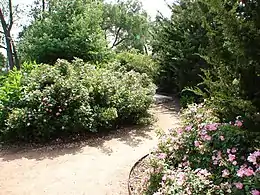
Jurisdiction

The Chicago Park District oversees more than 600 parks with over 8,800 acres (3,600 ha) of municipal parkland as well as 27 beaches, 78 pools, 11 museums, two world-class conservatories, 16 historic lagoons and 10 bird and wildlife gardens that are found within the city limits.[2] A number of these are tourist destinations, most notably Lincoln Park, Chicago's largest park which has over 20 million visitors each year, second only to Central Park in New York City.[3] With 10 lakefront harbors located within a number of parks along the lakefront, the Chicago Park District is also the nation's largest municipal harbor system.
A number of Chicago Park District parks are located in the vicinity of or even adjacent to a number of Chicago Public Schools. This design was done in order to make it easier for public school students and faculty to incorporate school assignments or physical activities into the learning experience. Additionally, a number of Chicago Public Library locations are sited within Chicago Park District facilities.
History
In the 1860s, Chicago already had about 40 small parks, but no central plan, and it fell far short when compared to other major cities in the country. Lincoln Park was Chicago's first large park, created in 1860. Dr. John H. Rauch MD, who was a member of the Chicago Board of Health and later a president of the Illinois State Board of Health, played a key role in establishing Lincoln Park by persuading city officials to close several festering cemeteries filled with shallow graves of victims of infectious epidemics. Rauch next formulated a central plan for parks across the entire city, noting that they were "the lungs of the city", and pointing out that Chicago's parks were inferior to those in New York's Central Park, Baltimore's Druid Hill Park, and Philadelphia's Fairmount Park. His influence was key in setting up Chicago's modern park system.[4]
The current Chicago Park District was created in 1934 by the Illinois Legislature under the Park Consolidation Act. By provisions of that act, the Chicago Park District consolidated and superseded the then-existing 22 separate park districts in Chicago, the largest three of which were the Lincoln Park, West Park, and South Park Districts, all of which had been established in 1869. In the late 1960s, the district lent its support for a Special Olympics for developmental challenged children. The Park District co-sponsored the first Special Olympics at Soldier Field in 1968.[5]
In the past several years, the Park District has initiated a program of renovating and beautifying existing parks and playgrounds, as well as initiating the building of a number of new parks, including Ping Tom Memorial Park, Ellis Park, DuSable Park Maggie Daley Park and others. The Chicago Park District has also expanded programming in neighborhood parks throughout the city, and created a lakefront concert venue on Northerly Island on the site of the former Meigs Field airport. In 2014, the district won the National Gold Medal Award for Excellence in Parks and Recreation.[6]
Museums in the Park
Park District land hosts 11 museums in locations around the city. They are:
- Adler Planetarium
- Art Institute of Chicago
- Chicago History Museum
- DuSable Museum of African American History
- The Field Museum
- John G. Shedd Aquarium
- National Museum of Mexican Art
- National Museum of Puerto Rican Arts and Culture
- Museum of Science and Industry
- Museum of Contemporary Art
- Peggy Notebaert Nature Museum[7]
In addition, the district's parks host the free admission Lincoln Park zoological park.,[8] the Garfield Park Conservatory,[9] and the Lincoln Park Conservatory.[10]
Image gallery
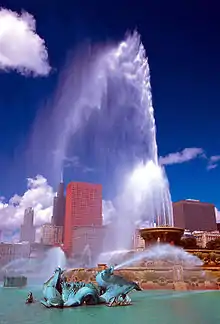 Buckingham Fountain, Grant Park
Buckingham Fountain, Grant Park Flagstone steps in Portage Park
Flagstone steps in Portage Park Osaka Japanese Garden in Jackson Park
Osaka Japanese Garden in Jackson Park Lincoln Park Zoo
Lincoln Park Zoo Lincoln Park in winter
Lincoln Park in winter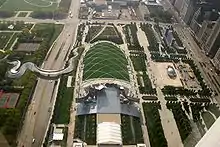 Millennium Park
Millennium Park Montrose Beach
Montrose Beach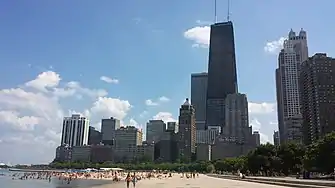 Oak Street Beach
Oak Street Beach
References
- Chicago Park District. "General Superintendent & Chief Executive Officer". chicagoparkdistrict.com. Archived from the original on 14 December 2013. Retrieved 29 March 2016.
- "About the Chicago Park District". Chicago Park District. Retrieved 16 November 2012.
- "City Park Facts". The Trust for Public Land, Center for City Park Excellence. June 2006. Retrieved 2006-07-19.
- William K. Beatty (1991) "John H. Rauch - Public Health, Parks, and Politics" Proceedings of the Institute of Medicine of Chicago Vol. 44 pp. 97-118
- "Flashback: 50 Yeas of Special Olympics". Chicago Tribune. Section 1. July 15, 2018. p. 23.CS1 maint: location (link)
- "Chicago Park District Wins Gold Medal Award from National Parks Groups". DNAinfo Chicago. Archived from the original on 10 January 2017. Retrieved 29 March 2016.
- "Museums In the Park: About Us". Retrieved 2013-05-27.
- "Lincoln Park Zoo". Chicago Park District. Retrieved 2018-09-19.
- "Garfield Park Conservatory – Garfield Park Conservatory Alliance". garfieldconservatory.org. Retrieved 2018-09-22.
- "Lincoln Park Conservancy - Conservatory & Gardens". lincolnparkconservancy.org. Retrieved 2018-09-22.